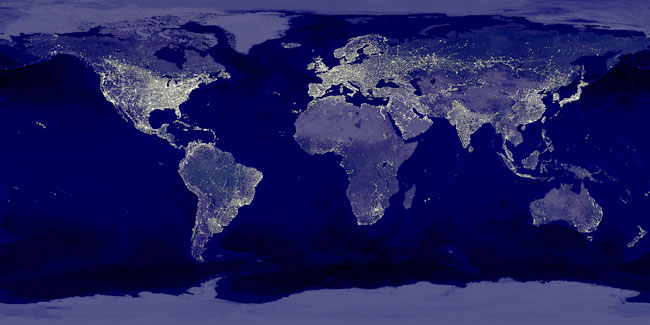Electric light
|
|
Most of the industrialized world is lit by electric lights, which are used both at night and to provide additional light during the daytime. These lights are normally powered by the electric grid, but some run on local generators, and emergency generators serve as backups in hospitals and other locations where a loss of power could be catastrophic. Battery-powered lights, usually called "flashlights" or "torches", are used for portability and as backups when the main lights fail.
Types
Types of electric lighting include:
- incandescent light bulbs
- arc lamps
- gas-discharge tubes, e.g., fluorescent lights, neon lamps, modern photographic flashes
- lasers
- light-emitting diodes, including OLEDs
- sulfur lamps
Different types of lights have vastly differing efficiency.[1] (http://www.parliament.the-stationery-office.co.uk/pa/cm200203/cmselect/cmsctech/747/747we81.htm)
| Name | Type of spectrum | Efficiency (lm/W) | Lifetime (MTBF) (hours) | Colour temperature (kelvins) | Colour |
| Incandescent | continuum | 13 | 1000 | 2700 | White |
| Tungsten halogen | continuum | 20 | 3000 | 3200 | White |
| Mercury | mercury line + Phosphor | 50 | 20000 | 3000* | Blue White |
| Metal Halide / HID | continuum | 80 | 10000 | 3500 | White |
| High pressure sodium | broadband | 95 | 30000 | 2000* | Peachy white |
| Low pressure sodium | narrow line | 200 | 20000 | not applicable | Orange-Yellow |
*Color temperature is defined as the temperature of a black body emitting a similar spectrum; these spectra are quite different from those of black bodies.
The most efficient source of electric light is the low-pressure sodium lamp. It produces an almost monochromatic orange light, which severely distorts color perception. For this reason, it is generally reserved for outdoor public lighting usages. Low-pressure sodium lights are favoured for public lighting by astronomers, since the light pollution that they generate can be easily filtered, contrary to broadband or continuous spectra.
Public lighting
The total amount of artificial light is sufficient for cities to be easily visible at night from the air, and from space. This wasted light should not be confused with the light pollution that burdens astronomers and others, although it is the source of it.

Human-made lights highlight particularly developed or populated areas of the Earth's surface, including the seaboards of Europe, the eastern United States, and Japan.
